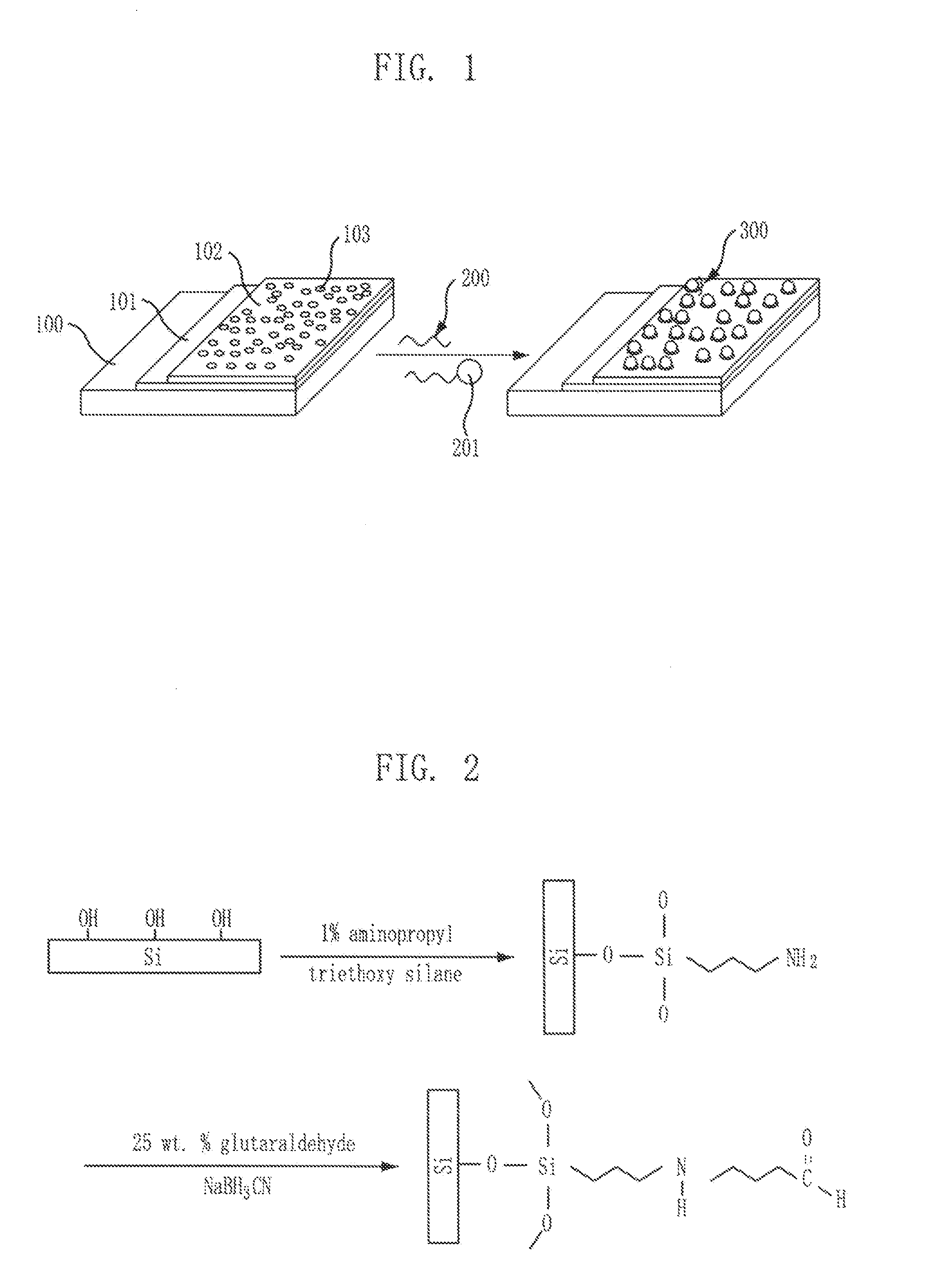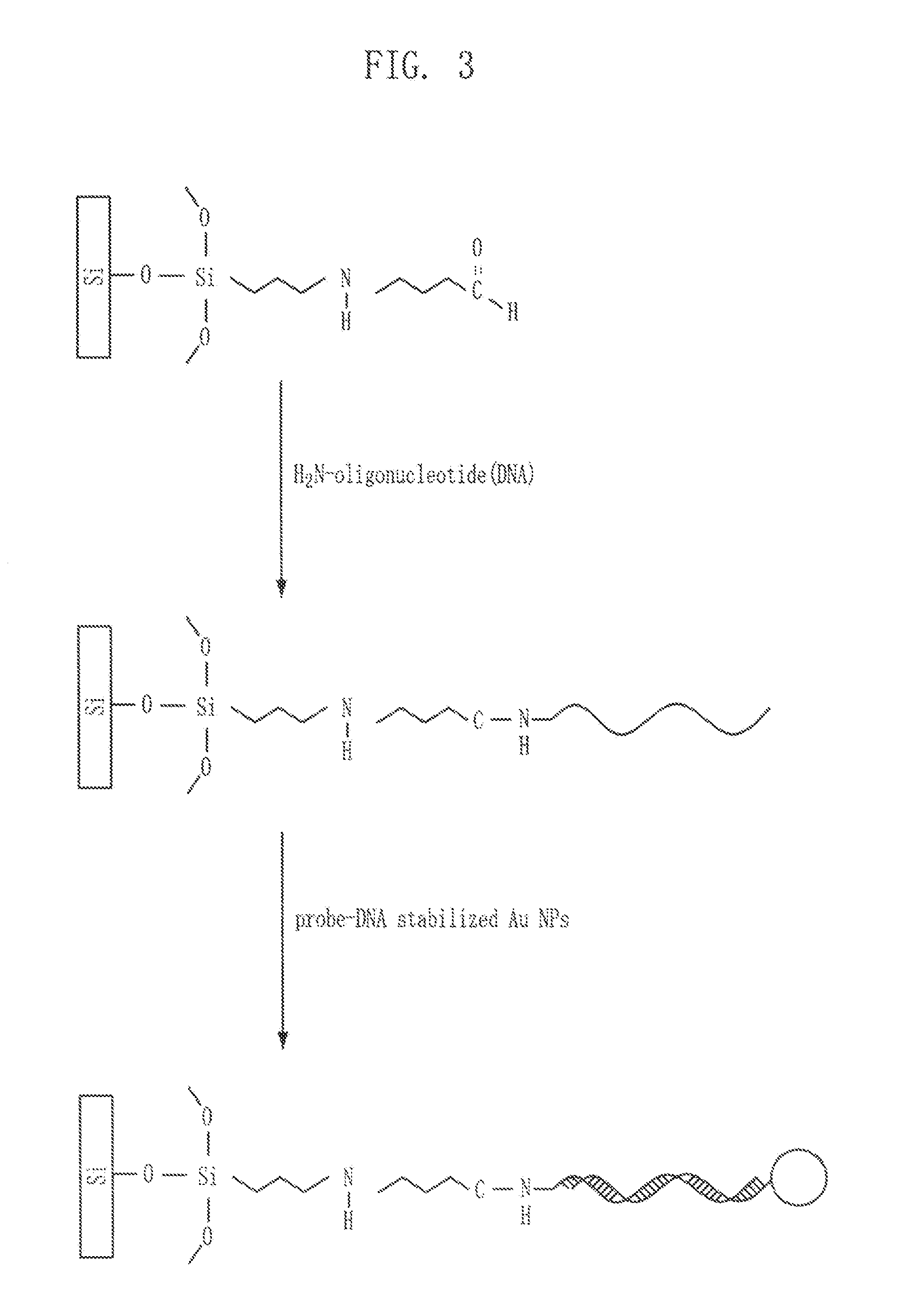Substrate for analyzing coverage of self-assembled molecules and analyzing method using the same
a self-assembled molecule and substrate technology, applied in the field of substrates for analyzing the coverage of self-assembled molecules and the analysis method of the same, can solve the problems of specialized analysis techniques, complicated analysis procedures, and high time and labor costs, and achieve the effect of efficient measurement of the presence of functional groups
- Summary
- Abstract
- Description
- Claims
- Application Information
AI Technical Summary
Benefits of technology
Problems solved by technology
Method used
Image
Examples
example
[0050]A substrate for analyzing the coverage of self-assembled molecules in accordance with the present invention was fabricated in the following method.
[0051]As shown in FIG. 1, an aldehyde functional group was introduced by using a silicon substrate Si. First, O2 plasma ashing was done to the silicon substrate Si for 5 minutes at 25 W to introduce a hydroxyl functional group. Next, the silicon substrate was dipped in 20 ml of an ethanol solution of 1% APTES (aminopropyl triethoxy silane) for 30 minutes, and then baked at 120° C., to thus introduce an amine functional group. Finally, the substrate was dipped in a 25 wt % glutaraldehyde solution having 0.1 g of NaBH3CN for two hours to introduce an aldehyde functional group.
[0052]FIG. 3 shows a process of attaching DNA-gold nanoparticles to a silicon substrate with an aldehyde group introduced thereto. First, a DNA molecule having an amine functional group at one end was dipped in 4 mM of an NaBH3CN reducing agent solution (pH 8.4) ...
experimental example
Measurement of Number of Nanoparticles Bound to Substrate Surface
[0053]The number of nanoparticles bound to the surface of the substrate fabricated through the foregoing embodiment was measured by using an FE-SEM, and the results thereof were shown in FIGS. 4 and 5 to 7.
[0054]FIG. 4 shows an FE-SEM image of nanoparticles that are introduced to a bulk silicon surface by chemically bounding and reacting a capture DNA containing an amine group produced in the foregoing embodiment with an aldehyde group present on the surface of a substrate and then complementarily binding nanoparticles stabilized by a probe DNA to the capture DNA. The nanoparticles have a diameter of 13 nm, and have a very good coverage of about 1,100 nanoparticles / μm2. The nanoparticles on the surface of the substrate are caused by the aldehyde group on the surface of the substrate, and thus it can be said that the coverage of the nanoparticles can replace the coverage of the aldehyde group present on a solid surface....
PUM
| Property | Measurement | Unit |
|---|---|---|
| diameter | aaaaa | aaaaa |
| pH | aaaaa | aaaaa |
| diameter | aaaaa | aaaaa |
Abstract
Description
Claims
Application Information
 Login to View More
Login to View More - R&D
- Intellectual Property
- Life Sciences
- Materials
- Tech Scout
- Unparalleled Data Quality
- Higher Quality Content
- 60% Fewer Hallucinations
Browse by: Latest US Patents, China's latest patents, Technical Efficacy Thesaurus, Application Domain, Technology Topic, Popular Technical Reports.
© 2025 PatSnap. All rights reserved.Legal|Privacy policy|Modern Slavery Act Transparency Statement|Sitemap|About US| Contact US: help@patsnap.com



